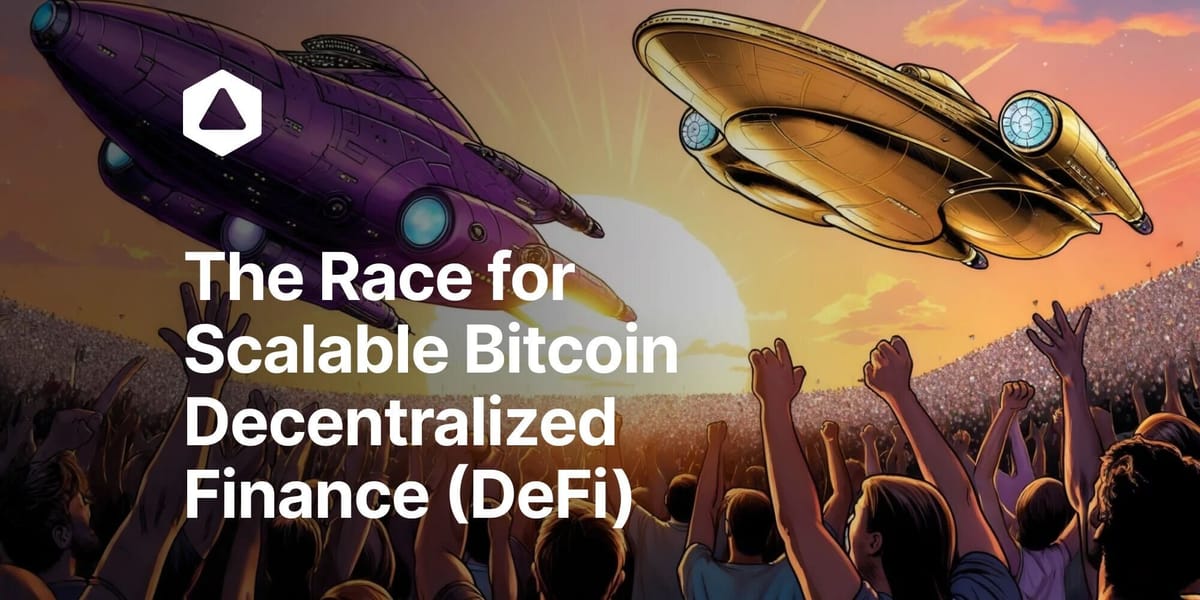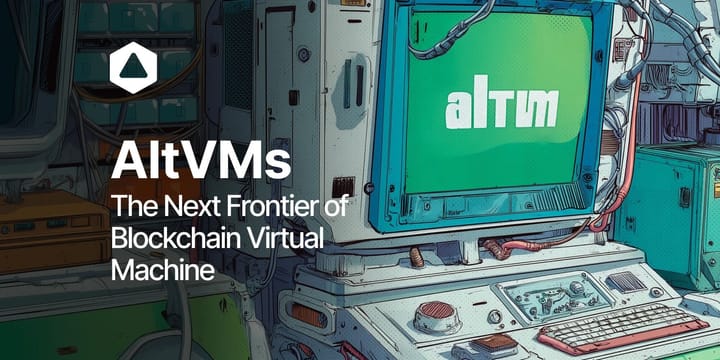The Race for Scalable Bitcoin Decentralized Finance (DeFi): Who’s Leading?
Dive into the evolving landscape of Bitcoin DeFi: Discover how Layer 2 solutions and innovative protocols are transforming Bitcoin's capabilities, bridging traditional limitations with next-generation financial applications.

Decentralized Finance (DeFi) has been a key aspect of the crypto ecosystem for a few years now, particularly challenging the limitations of traditional finance. Since its introduction to the Bitcoin blockchain, several protocols have launched DeFi capabilities on the Bitcoin blockchain. But we are still very early.
This article discusses the different protocols that are launching DeFi projects on Bitcoin and their position in offering DeFi capabilities on the Bitcoin blockchain.
Understanding Bitcoin’s Blockchain Operation
The Bitcoin blockchain operates with the proof-of-work consensus algorithm, which requires solving complex mathematical problems to validate transactions and secure the network.
This consensus mechanism ensures high security for Bitcoin. However, unlike its counterpart blockchains such as Ethereum and Solana, it doesn't support smart contracts—a major backbone of DeFi. Bitcoin lacks this functionality.
The absence of smart contract functionality has given Ethereum an edge, allowing it to lead the DeFi race, which now accounts for 55% of the Total Value Locked (TVL). Ethereum is still the reigning king of DeFi.

But if it is for many, this will not stay for long. For Bitcoin to join the DeFi race and support its features and multiple applications, it must first overcome limitations that hold it back.
Bitcoin’s Original Design and Limitations Regarding DeFi
Bitcoin's original design as a decentralized digital currency includes several elements that do not support the DeFi vision. These core elements include:
UTXO Model
UTXO stands for Unspent Transaction Output. This model is efficient for simple transfers but lacks the flexibility required for complex smart contracts.
Think of the UTXO model like cash: when you spend part of a bill, you receive change back. While this works for simple transactions, it’s inefficient for DeFi because smart contracts require managing multiple states and conditions across transactions.
Bitcoin's UTXO system isn't designed for this complexity, which places a limit on its ability to support advanced DeFi functionalities.

Limited Scripting
Bitcoin’s scripting language is intentionally limited to maintain security; however, this means it cannot handle the complex logic needed for advanced DeFi applications.
Bitcoin’s scripting language consists of a simple set of instructions used to verify and execute basic transactions on the Bitcoin network.
But solutions to the limiting scripting problem have been found, as Bitfinity bridges the knowledge of Ethereum to the Bitcoin ecosystem.

Lack of Turing Completeness
Unlike Ethereum, Bitcoin cannot natively support complex, state-dependent smart contracts.
"State-dependent" in this context means that the smart contract’s outcome relies on the current state or conditions of the system, which can change over time. In Bitcoin, it cannot effectively track these changing states. The EVM Factor: Analyzing the Potential Impact of Ethereum Compatibility on Bitcoin Layer 2s

Block Size and Transaction Speed
The 1MB block size limit and 10-minute block time reduce Bitcoin's transaction throughput, is too slow for fast Dapps, this is by far the most counter argument for the effectivity of large-scale applications like DeFi. That being said, it has even created division between Bitcoin tribes and perhaps created the 'term' maximalism.

The absence of these core elements makes it difficult to build platforms such as decentralized exchanges, lending platforms, or yield farming protocols directly on Bitcoin, all of which combined we call DeFi.

So, What Exactly is Bitcoin DeFi?
As the name suggests, Bitcoin decentralized finance, or Bitcoin DeFi, sometimes also referred as BTCFI, refers to the development of DeFi on the Bitcoin blockchain. Plain and simple.
Because of the core limitations of Bitcoin (as described earlier), the enhanced capabilities that facilitate DeFi have been made possible through the introduction of extra Bitcoin layers, that have benefited from certain upgrades to the Bitcoin protocol.

Some Bitcoin features or Layer 1 upgrades that needed to be made include changes like Schnorr Signatures and Taproot. While you can read about them in previous articles, these upgrades have improved transaction privacy and scalability and introduced more complex smart contract functionalities and paved the way for innovations like Ordinals and BRC-20 tokens, which mimic the famous and mostly used Ethereum's ERC-20 standard.

Exploring the Building Blocks of Bitcoin DeFi
Similar to the core features, three elements serve as the main building blocks of Bitcoin DeFi, explained thoroughly below.
Bitfinity as a DeFi 'Facilitatooor'
You probably know, but you are reading a Bitfinity blog post, and by that you know we are active as a solution that wants to facilitate DeFi in a similar fashion as it is possible on Ethereum. Well and we are close to achieving this as we bridge the capabilities of the mainnet with a few new features such as the ICP's technology chainfusion which essentially means different blockchains interacting with one another, paired of course with the robustness of the Bitcoin blockchain.
In a nutshell, Bitfinity is a secondary protocol designed to drastically improve transaction speed and make it more scalable. Of course this is what we need when we want to run DeFi apps in a good and clean version, and efficiency without compromising the security and decentralization of the Bitcoin network.
Which apps could run on us? Well there are several Bitcoin DeFi apps that make up our ecosystem, each with distinct functionalities. Here are a few briefly explained.
DotSwap
DotSwap is a Bitcoin-based DeFi platform that secures, trustless swaps of BTC and BRC20 assets within the Bitcoin ecosystem. As the first native BRC20 swap, it combines easy AMM trading with strict adherence to Bitcoin principles. With $886.96k in daily trading volume, DotSwap is still small but wants to create DeFi on Bitcoin in a big way.

Bitcoin Virtual Machine (BVM)
The Bitcoin Virtual Machine (BVM) is a development platform that brings decentralized applications that make up DeFi and gaming to the Bitcoin network. It also supports Solidity smart contracts and has EVM compatibility.

BiHelix
BiHelix is also an application framework layer for Bitcoin, built on the Lightning Network and RGB protocol for the Bitcoin Blockchain. It is designed to support the development of any type of dApp, from AI, games to DeFi on the Bitcoin Blockchain.

BitStable Finance
BitStable is a decentralized protocol that builds on Bitcoin’s capabilities by offering DAII, a Bitcoin-backed stablecoin linked to currencies and commodities, and BSSB, a token used for governance decisions. To learn more about stables on Bitcoin, take a look here.

BitSmiley Protocol
The BitSmiley Protocol is built on the Bitcoin blockchain via the Fintegra framework and integrates an overcollateralized decentralized stablecoin (bitUSD) which is a trustless lending platform (bitLending), and a derivatives protocol (bitCredit) to create a unified ecosystem for stablecoins, lending, and credit-based needed for DeFi.
Liquidium
Liquidum is the first peer-to-peer, non-custodial Bitcoin DeFi application, that allows users to borrow and lend Bitcoin or Bitcoin-based assets—such as Inscriptions, Ordinals, Runes, and BRC-20 tokens—by leveraging Discreet Log Contracts (DLCs).

Final Thoughts
As we come to the conclusion of our article we see that many will try to create Bitcoin DeFi. Many will fail probably, but as we are shaping up to be a game-changer by finding ways to get around Bitcoin's limitations we could perhaps help others succeed by providing a bridge between the old and the new finance (in crypto that is).
By leveraging Ethereum's capabilities, which is proven to be huge for utility and inclusiveness. It means developers can deploy Ethereum-based apps directly on Bitcoin using Solidity via Bitfintiy. So Bitcoin gets Ethereum's rich DeFi app ecosystem, expanding what it can do.
This could also mean that there is less need to build new apps from scratch. Developers and users can use their favorite Ethereum DeFi apps on Bitcoin, improving experience and adoption without reinventing the (fly)wheel.

Connect with Bitfinity Network
Bitfinity Wallet | Bitfinity Network | Twitter | Telegram | Discord | Github

*Important Disclaimer: The information provided on this website is for general informational purposes only and should not be considered financial or investment advice. While we strive for accuracy, Bitfinity makes no representations or warranties regarding the completeness, accuracy, or reliability of the content and is not responsible for any errors or omissions, or for any outcomes resulting from the use of this information. The content may include opinions and forward-looking statements that involve risks and uncertainties, and any reliance on this information is at your own risk.
External links are provided for convenience, and we recommend verifying information before taking any action. Bitfinity is not liable for any direct or indirect losses or damages arising from the use of this information.


















Comments ()